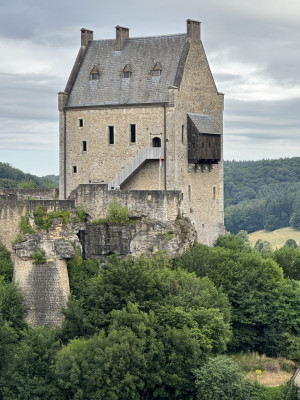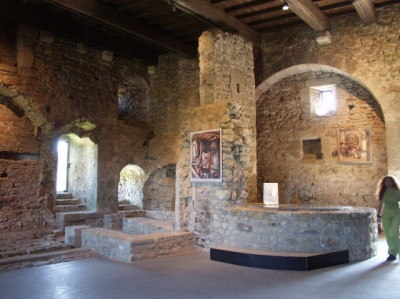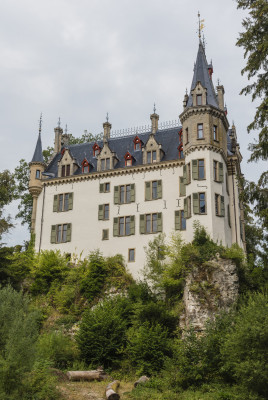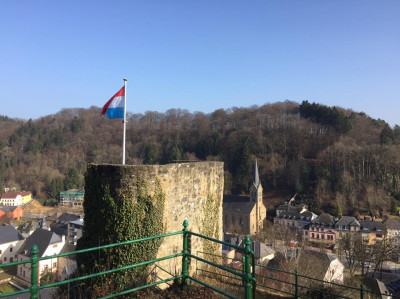
High on a promontory of Luxembourg sandstone, the ruins of Larochette Castle dominate the valley of the White Ernz, a confluence of the river Sure. One can reach this promontory through a large farmyard protected by an earth fortification.
The main castle, built of sandstone, is surrounded by a wall, mostly destroyed today. A deep ditch, partly of natural origin, cuts the castle in two. At the far end of the promontory, the ruins of several seigniorial mansions witness the quality of the architecture of this castle.
Since its acquisition by the Luxembourg state in 1979, this historical part of Larochette has seen numerous restorations and valuations. Photogrammetical pictures taken at the purchase of the castle were completed by archeological studies still continuing.
The Lords of Larochette are first mentioned at the end of the XII century, among others as banner carrier for the House of Luxembourg. At the end of the XIV century, 5 seigniorial houses stood inside the walls of the castle. The Hombourg Mansion was constructed around 1350 as the brothers Frederic and Conrad, Lords of Hombourg, married the sisters Irmgard and Mathilde of Larochette. The Crehange House was built around 1385. At the end of the XVI century however, the castle was destroyed by a fire and remained in ruins. The Crehange House, of formidable architecture, was restored from 1983 to 1987. The Hombourg Mansion is still being consolidated.
Besides the restoration and consolidation, vast excavations took place all over the area of the castle. The results of this archeological founds will allow to complete the knowledge about the history of the castle. It seems as if the origins of the Lords of Larochette were in Ouren. They became very influent and, from the XIIIth century, they were the most true vassals of the Count of Luxembourg. The German Emperor Wenceslas even allowed the Lords of Fels to have their own money in 1402.
Inside the Castle, in the "Créhange House", a deep well is carved into the massive stone rocks. A legend tells of the Lady who panicked as the enemy stormed the castle. She sprang into the well along with her infant child. Impressed of so much heroic courage, the aggressors stopped and they rescued the innocent victims from the well. As they needed a guilty party for the disgrace, they found the steward of the castle, who through his treachery had made the storming possible. They threw him into the well. The steward was transformed into a dragon who watches over the gold which he took in payment for his betrayal, and which lies in the well.
Apparently on each good Friday he awakes and emerges from the well at midnight and leads off a hellish round in the castle's keep.

Besides the Castle of Larochette, the castle of Meysembourg is also in the commune of Larochette. It is privately owned and can not be visited, but it can be reached by the L2 walk through the magnificent valley of the "Manzebaach".
The actual building was constructed here in 1880 by Prince von Arenberg following the plans of architect Charles Arendt, in a composite Neo-Renaissance style. In 2011 it was bought by actual owner. Only the chapel, the moat, and a portion of the protective wall remain from the original castle.
But the people of Meysembourg, mentioned as early as the 12th century, did not just play a secondary role in the history of the country. A Dame of Meysembourg for example, was the confidante of Countess Ermesinde and a lord of Meysembourg was appointed an executor of wills by John the Blind. Unfortunately, he did not have the opportunity to exercise his function, since he was killed with the blind king on the battlefield at Crécy. The ancient Meysembourg castle was devoured by fire twice but each time rebuilt. Lord Custine from Wiltz was the last descendant, by marriage, of the Meysembourg line. He fled the country in 1794, escaping from the French.
The castle became the property of the Lords of Fischbach, of Cassal, and of Johann-Franz Reuter of Heddersdorf who tore down the adjacent village after he chased away its inhabitants (they mostly emigrated to the United States). Finally it was acquired by the von Arenberg family who demolished it before building the actual castle.


At the rocky promontory opposite on the south side of the castle is an old watchtower named "Verlorenkost”. The funny name means "lost food" and the story tells that during the construction a cook carried the meals to the builders. She stumbled and smashed the pots with the food. The food (kost) was then lost (verloren) giving the tower its name which it still retains today.
Another story says that the tower could never be used as a watchtower as it stands on the wrong place. The building was thus a "lost cost".